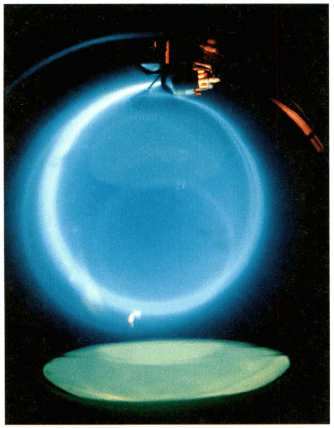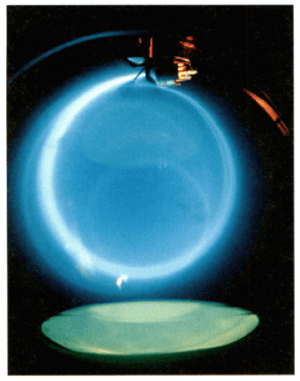David Sang and Graham Jones Solutions for Chapter: Motion of Charged Particles, Exercise 4: Questions
David Sang Physics Solutions for Exercise - David Sang and Graham Jones Solutions for Chapter: Motion of Charged Particles, Exercise 4: Questions
Attempt the free practice questions on Chapter 25: Motion of Charged Particles, Exercise 4: Questions with hints and solutions to strengthen your understanding. Physics for Cambridge International AS & A Level Coursebook 3rd Edition Digital Access solutions are prepared by Experienced Embibe Experts.
Questions from David Sang and Graham Jones Solutions for Chapter: Motion of Charged Particles, Exercise 4: Questions with Hints & Solutions
Look at the photograph of the electron beam in the fine-beam tube.
State the direction is the magnetic field (into or out of the plane of the photograph).

In this fine-beam tube, a beam of electrons is bent around into a circular orbit by a uniform magnetic field. The beam is shown up by the presence of a small amount of gas in the tube.
The particles in the circular beam shown in Figure all travel round in the same orbit. State what can you deduce about their mass, charge and speed.

In this fine-beam tube, a beam of electrons is bent around into a circular orbit by a uniform magnetic field. The beam is shown up by the presence of a small amount of gas in the tube.
An electron beam in a vacuum tube is directed at right angles to a magnetic field, so that it travels along a circular path. Predict the effect on the size and shape of the path that would be produced (separately) by each of the following changes:
(a) increasing the magnetic flux density.
An electron beam in a vacuum tube is directed at right angles to a magnetic field, so that it travels along a circular path. Predict the effect on the size and shape of the path that would be produced (separately) by each of the following changes:
(b) reversing the direction of the magnetic field.
An electron beam in a vacuum tube is directed at right angles to a magnetic field, so that it travels along a circular path. Predict the effect on the size and shape of the path that would be produced (separately) by each of the following changes.
(C) slowing down the electrons.
An electron beam in a vacuum tube is directed at right angles to a magnetic field, so that it travels along a circular path. Predict the effect on the size and shape of the path that would be produced (separately) by each of the following changes.
(d) tilting the beam, so that the electrons have a component of velocity along the magnetic field.
